 |
Locking Plugs overview of types in museum |
info page |
| Locking plugs prevent accidental
disconnection that may have unwanted and possibly dangerous
consequences because
lighting fails or equipment comes to an untimely or unsafe stop. Various mechanisms have been designed to secure special plugs in combination with adapted sockets. An overview of classic and modern locking plugs in the museum collection is given below. → Click on
an
image for additional information and matching socket.
|
 |
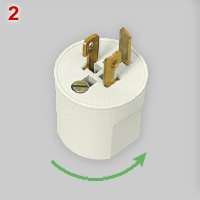 |
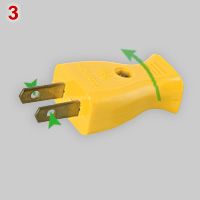 |
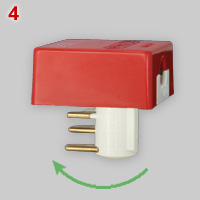 |
| 1 | The US
National Electrical Manufacturers Association (NEMA) has defined a
large number of amperage, voltage and grounding specific locking plug
configurations. Pins of twist lock plugs are rounded and have a flange
to lock the plug
(see green arrow). |
| 2 | Danish twist lock
plug for
ceiling sockets, designed to connect lamps. Locking mechanism is
comparable to US plugs (see no. 1). |
| 3 | Japanese locking
sockets use the holes in flat blades to fix a plug after rotation. See
also nos 17 and 18. |
| 4 | British EPOS
(Electric Point of Sale) plug. After insertion in a matching socket the
plug is locked by rotating 90°. |
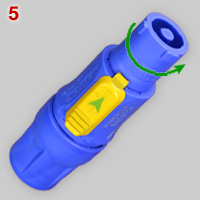 |
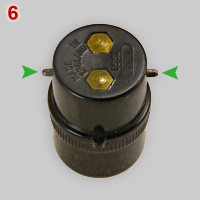 |
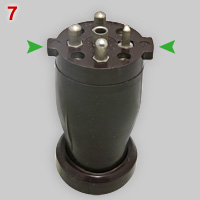 |
| 5 | Neutrik
PowerCON plug. After insertion in a PowerCON socket and 30° rotation,
the yellow clip locks the plug. |
| 6 | British bayonet cap
plug. Bayonet plugs were initially meant for lighting only, but
adapters for BS 372 2-pin plugs existed also. |
| 7 | Three-phase plug
with bayonet-type locking mechanism, made by the German company Kontakt
AG
in the 1930s. |
 |
 |
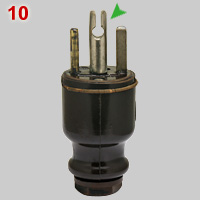 |
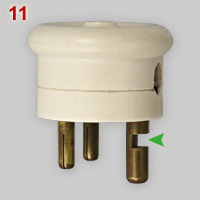 |
| 8 | Plug with a screwed,
restraining ring to secure the plug after inserting in a socket with
matching spiral thread. |
| 9 | Concentric plug with
locking mechanism similar to no. 8. The German Maehler & Kaege plug
dates back to the 1950s. |
| 10 | A cutout of the
earth pin (green arrow) enables the matching socket to secure the plug
with
a bar. Locking mechanism has been designed also by Maehler & Kaege.
Dating: early 1930s. |
| 11 | British plug with
slotted earth pin, made in
the 1950s by General Electric Company. Locking mechanism is comparable
to no. 10. |
 |
 |
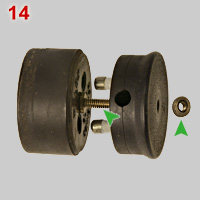
|
 |
| 12 | IEC
60329-C13
connector plug. When pushing the connector into an appliance inlet, the
metal plate (green arrow) glides easily around the inlet earth pin
but blocks attempts to retract the connector. |
| 13 | French DCL plug
(Dispositif de Connection Luminaire). A clip (green arrow) locks the
plug in a DCL lamp socket. |
| 14 | Wylex clock
connector. A long screw keeps socket and plug together. Dating: 1950s. |
| 15 | Plug
with hollow pins. The cavity is slightly conical. Pin tips can be
pushed away from each other by a (black) plastic bar; triangles (green
arrowheads) fix pins in the socket contact. |
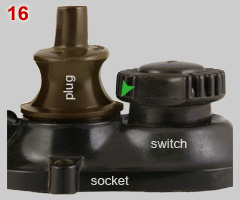 |
 |
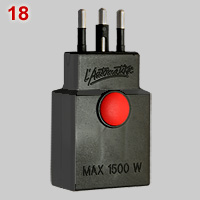 |
| 16 | Plug is a standard Schuko model inserted into a socket with rotary switch. In switched on position, the knob of the switch locks the plug. It is essential that the plug has a collar (green arrowhead). Nearly all classic Schuko plugs had a collar. |
| 17 | Connector with mechanism to lock
CEE 7/4, -7/6, -7/7 and -7/17 plugs. Rotate connector collar to lock /
unlock
plug. |
| 18 | Adapter
plug with locking mechanism connected to tube around earth pin. Press
red button to unlock plug. Click image for details. |
| In the true sense of the word, plugs 19 - 22 are not
locking plugs. Straight blades of plugs 19 and 20 have holes. Matching
sockets have small balls that fit partially in the
holes. Balls help to keep plugs in position. Pins of plugs 21 and 22 show other types of plug fixation; see captions. |
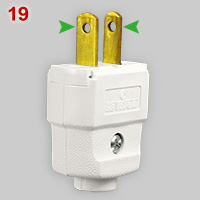 |
 |
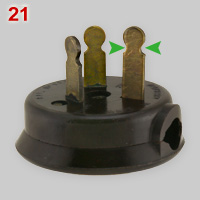 |
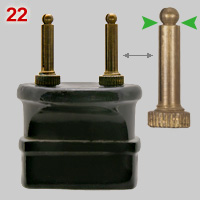 |
| 19 | US 15A-125V non
grounding plug. Although not
compulsory, many US straight blades have
holes that help to fix plugs. See nos. 1 (US) and 3 (Japan) for genuine locking plugs. |
| 20 | Classic Danish plug
designed for lamp sockets. Image No. 2 shows a modern, locking
type Danish lamp plug. |
| 21 | Classic
Australian 10A plugs often had recesses at the top of each of the
blades (green arrows). Their function was comparable to holes
in straight blades (see nos 17 and 18). Already in 1904 Harvey Hubbell
patented plug blades with recesses and
matching outlet contacts with indentations adapted to engage blade
recesses (see images A, C and D on Origin of US plugs and sockets
page). Ultimately the Hubbell method of
fixing plugs has been outstripped by the "hole and ball" method shown
in image no. 17. The origin of Australian plugs is a 1915 design by George Knapp, working at Hubbell Inc. (see image E). Whether Australian sockets initially had contacts with indentations is not clear. None of the classic outlets in the museum collection have the provision. Modern Australian plugs have flat blades without recesses or holes. |
| 22 | Porcelain
round pin plug made in Germany in the 1910s. They often had
round pin tips, which helps to insert plugs into socket contacts. The
additional circular recess is either a decorative feature, or -
occasionaly - a provision to fix plugs. An example of the latter
function is
shown on Classic
Uncommon Plugs page (see Voigt & Haeffner socket no. 28). |
| |
D i g i t a l M u s e u m o f | |
P l u g s a n d S o c k e t s | |